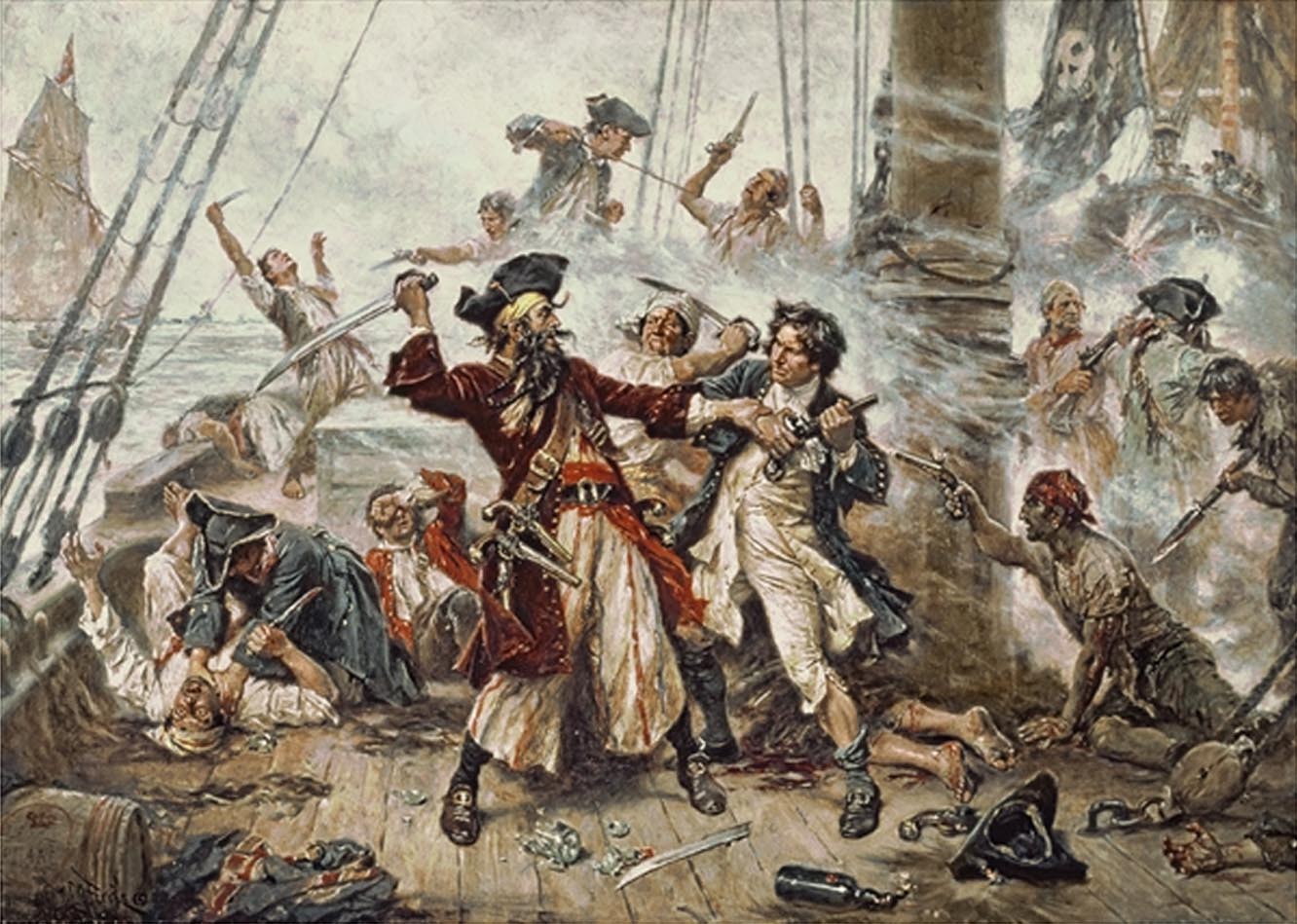 Pirates and Privateers Pirates and Privateers
The History of Maritime
Piracy
Cindy Vallar, Editor
& Reviewer
P.O. Box 425,
Keller, TX 76244-0425
    
Pirate
Tactics
by Cindy Vallar

Boarding by unknown artist
(Source: Dover's Pirates)
Contrary
to popular opinion, pirates rarely just spied a ship
and attacked it. They gathered intelligence about
their target and the people who guarded it and
considered “what if” scenarios. Planning only worked
if the details were kept secret, so only those with
a need to know participated in this stage of the
project.
 Before any attack could
be planned, pirates needed to acquire information
about possible targets. The more knowledge gathered,
the better their chance of success. Where did they
acquire information about potential targets? Taverns
and coffeehouses
were ideal places to learn about incoming and
outgoing ships. Who commanded a vessel? How many men
were aboard? What cargo did she carry? Before any attack could
be planned, pirates needed to acquire information
about possible targets. The more knowledge gathered,
the better their chance of success. Where did they
acquire information about potential targets? Taverns
and coffeehouses
were ideal places to learn about incoming and
outgoing ships. Who commanded a vessel? How many men
were aboard? What cargo did she carry?
In A New
Voyage Round the World, published in
1697, William
Dampier described what type of information his
fellow buccaneers sought when planning a raid on a Spanish
town.
For the
privateers . . . make it their business to
examine all prisoners that fall into their
hands, concerning the country, town, or city
that they belong to; whether born there, or how
long they have known it? How many families,
whether most Spaniards? Or whether the major
part are not copper-colour’d, as Mulattoes,
Mustesoes, or Indians? Whether rich, and what
their riches do consist in? And what their
chiefest manufactures? If fortified, how many
great guns, and what number of small arms?
Whether it is possible to come undescrib’d on
them? How many look-outs or centinels; for such
the Spaniards always keep? And how the look-outs
are placed? Whether possible to avoid the best
landing; with innumerable other such questions,
which their curiosities led them to demand. And
if they have had any former discourse of such
places from other prisoners, they compare one
with the other; then examine again, and enquire
if he or any of them are capable to be guides to
conduct a party of men thither: if not, where
and how any prisoner may be taken that may do
it; and from thence they afterwards lay their
schemes to prosecute whatever design they take
in hand. (Little, 80)
 Pirates
always interrogated sailors and passengers on seized
vessels. The threat of torture was often enough to
make them talk, but when necessary, pirates tortured
their prisoners. This information needed to be
confirmed whenever possible, for victims would lie
in hopes of saving their lives. Torture also
revealed hidden booty aboard the prize. On 14
September 1723, Princess had almost reached
Barbados when George
Lowther attacked. Successful in the capture,
he and his men put lit fuses between the fingers of
the surgeon and second mate until the two men
revealed the hiding place of fifty-four ounces of
gold. Pirates
always interrogated sailors and passengers on seized
vessels. The threat of torture was often enough to
make them talk, but when necessary, pirates tortured
their prisoners. This information needed to be
confirmed whenever possible, for victims would lie
in hopes of saving their lives. Torture also
revealed hidden booty aboard the prize. On 14
September 1723, Princess had almost reached
Barbados when George
Lowther attacked. Successful in the capture,
he and his men put lit fuses between the fingers of
the surgeon and second mate until the two men
revealed the hiding place of fifty-four ounces of
gold.
Yet prisoners and places frequented by sailors
weren’t the only sources of information pirates used
in gathering intelligence. Merchants, smugglers,
native peoples, cimarrones
(escaped slaves), and others who lived on the
fringes of society or were friendly to pirates also
supplied vital information. Whenever possible,
pirates compared new revelations with what they
already knew or had heard to verify the truth of the
intelligence.
How did pirates locate potential targets? Sometimes,
they sailed near established trade routes and
attacked whatever ships crossed their path. Other
times, they hid in coves or straits where they
waited to ambush unsuspecting prey. In these cases,
pirates relied on their acquired knowledge of where
ships passed at given seasons of the year rather
than gathering more detailed information on possible
targets. Pirates preferred hunting in coastal waters
instead of the open sea because “[a] ship crossing
from England to the New York colony might sight many
sail during the voyage, or none at all.” (Little,
77) At some point, all vessels navigated coastal
waters, so while the risk increased when pirates
cruised close to shore, this area also provided the
greatest potential for locating prizes.
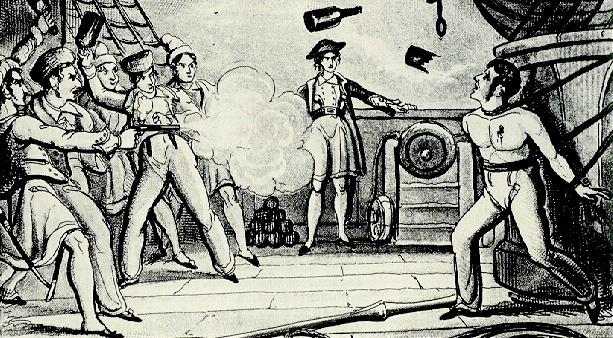
Pirates toss bottles at a
prisoner bound to the capstan
(Source: Pirate
Images)
The more familiar with the region pirates were, the
better their chances of finding prey. Accurate nautical
charts and knowledge of hazardous waters were
essential for any captain and/or navigator. If the
wait took too long, they might need to replenish
food and water, so knowledge of where to find these
supplies was important. Pirates also seized
waggoners, charts, logs, and other ship’s papers,
which might reveal the departure or arrival of
treasure ships or vessels carrying prized cargo.
Although sometimes incorrect, charts and atlases
provided pertinent details for navigating coastal
waters and locations where the vessels could hide,
careen, or resupply.
Other times, pirates targeted a specific ship,
although this was often the more dangerous way to
gain riches. They had to acquire information about
the ship, her cargo, and her approximate arrival or
departure time. No amount of intelligence gathering
guaranteed success, for unlike today, ships didn’t
arrive or depart on schedule. In this scenario,
pirates also had to consider “[v]ariables such as
wind, weather, quantities of provisions, wood, or
water, and simple timing” because each could impact
the mission’s success or failure. (Little, 76) If an
attack succeeded, one prize could make a pirate rich
beyond his dreams.
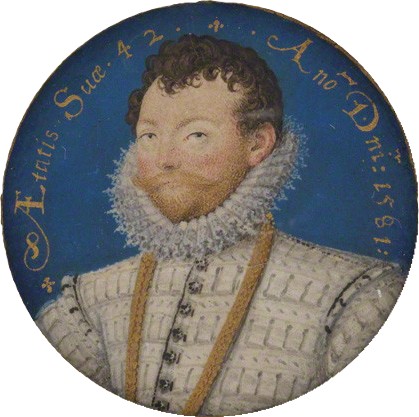 In
1579, Francis
Drake learned from a captured Spanish officer
that three treasure ships were expected – one bound
for Panama and two for Callao. Drake ordered a
captured Portuguese pilot to sail Golden
Hinde to Callao. Upon entering Lima’s
port city, almost half of Drake’s seventy crew
members boarded smaller vessels to sail close to the
anchored Spanish ships and cut their cables. Drake
hoped to seize the ships after the wind carried them
out to sea, but the wind died and the enemy ships
failed to move anywhere. As a result, he sailed
toward Panama to intercept the great galleon laden
with silver. In
1579, Francis
Drake learned from a captured Spanish officer
that three treasure ships were expected – one bound
for Panama and two for Callao. Drake ordered a
captured Portuguese pilot to sail Golden
Hinde to Callao. Upon entering Lima’s
port city, almost half of Drake’s seventy crew
members boarded smaller vessels to sail close to the
anchored Spanish ships and cut their cables. Drake
hoped to seize the ships after the wind carried them
out to sea, but the wind died and the enemy ships
failed to move anywhere. As a result, he sailed
toward Panama to intercept the great galleon laden
with silver.
Nuestra
Señora de la Concepción was sighted on 1
March. Rather than follow it, Drake
pretended to do the opposite. He also hung cables
and mattresses over the side of Golden Hinde
to slow the vessel. When the two ships came within
shouting distance, one of Drake’s prisoners warned
the captain of Concepción, so Drake ordered
marksmen to fire a volley and for bow chasers to
fire chain shot, which brought down the mizzenmast.
After Drake’s gunners fired shot from a larger gun,
the Spaniards surrendered while English archers
boarded the galleon. Concepción carried “a
great quantity of plate, 80 lb of gold, and 26 tons
of uncoined silver[,]” according to a contemporary
report, and it took five trips and six days to
transfer the booty to the Golden Hinde.
(Cordingly, 30) Today, the treasure would be worth
around UK £14 million (US $26 million), and was
sufficient not only to make rich men of all aboard
but also allowed Queen Elizabeth to pay
off her foreign debt.
 Pirates
didn’t always attack ships, especially the buccaneers
of the seventeenth century. When they raided land
targets, they had to determine which weapons and
supplies were essential to achieve their goal.
Sometimes, the best way to secure information for
this type of operation was to spy out the terrain. A
year before Drake raided Nombre de
Dios, a port city on the Isthmus of Panama in
1572, he donned the disguise of a Spanish merchant
and visited the town where “. . . he inspected the
harbor and noted the location of the King’s
treasure-house. He had found a sheltered cove nearby
which would provide a safe anchorage. . . . He also
made contact with some of the escaped black slaves
called Cimaroons who lived in the surrounding jungle
and were always ready to revenge themselves on the
hated Spanish.” (Cordingly, 26-27) Pirates
didn’t always attack ships, especially the buccaneers
of the seventeenth century. When they raided land
targets, they had to determine which weapons and
supplies were essential to achieve their goal.
Sometimes, the best way to secure information for
this type of operation was to spy out the terrain. A
year before Drake raided Nombre de
Dios, a port city on the Isthmus of Panama in
1572, he donned the disguise of a Spanish merchant
and visited the town where “. . . he inspected the
harbor and noted the location of the King’s
treasure-house. He had found a sheltered cove nearby
which would provide a safe anchorage. . . . He also
made contact with some of the escaped black slaves
called Cimaroons who lived in the surrounding jungle
and were always ready to revenge themselves on the
hated Spanish.” (Cordingly, 26-27)
Once the intelligence was gathered and a plan
formulated, pirates set out on their venture. Their
leader, the captain, was someone willing to step
into the fray rather than wait on the sidelines
while his men did battle. His courage and daring
were essential, but so were his ability to be
flexible and his willingness to adapt his plans to
fit the altered situation. Pirates might plan for
every possible contingency, but fate often delivered
something unexpected.
When Drake and his band of seventy-three men
attacked Nombre de Dios, their first goal was to put
the shore battery of six guns out of commission.
Having achieved this, they divided; Drake attacked
from the east while his brother created a diversion
to the west. “Drake . . . marched into the town with
beating drums and the sounding of trumpets. There
was panic from the inhabitants, who imagined they
were being attacked by a huge force.” (Cordingly,
27) Then the unexpected occurred. Spanish soldiers
wounded Drake in the thigh, and a thunderstorm
soaked the pirates’ powder and matches, making their
weapons useless. The men wanted to give up, but
Drake convinced them otherwise. Ignoring the pain,
he led them to the treasure house, but once inside,
they found it empty. The treasure fleet had sailed
six weeks earlier; another shipment wouldn’t arrive
for months.
Whether the attack occurred on land or at sea,
surprise was essential. On land, fewer citizens had
a chance to hide their valuables or escape with
them. At sea, fewer pirates died and the prize
sustained less damage. Speed and mobility were also
important to the success of attacks. This was why
pirates favored fast ships that were easy to
maneuver and had shallow drafts.
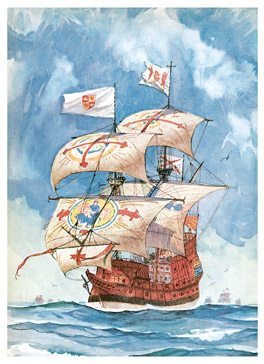 Once the lookout
sighted a potential target, the pirates did not
immediately attack. They stalked the prey to
identify the type of ship, whether she rode low or
high in the water (full cargo vs. empty hold), and
to determine the prey’s possible firepower. This
intelligence gathering took several hours to several
days. “To discern the details of armament and crew
of an unknown vessel by naked sight alone – whether,
for example, the crew were many or few, and how many
ports or cannon the vessel might have – it had to be
no more than a few hundred yards away, and even then
many details were obscure. And because most
nations had other nations’ vessels in their naval
and merchant fleets . . . it was not possible to
determine nationality solely from design or general
characteristics.” (Little, 109) Once the lookout
sighted a potential target, the pirates did not
immediately attack. They stalked the prey to
identify the type of ship, whether she rode low or
high in the water (full cargo vs. empty hold), and
to determine the prey’s possible firepower. This
intelligence gathering took several hours to several
days. “To discern the details of armament and crew
of an unknown vessel by naked sight alone – whether,
for example, the crew were many or few, and how many
ports or cannon the vessel might have – it had to be
no more than a few hundred yards away, and even then
many details were obscure. And because most
nations had other nations’ vessels in their naval
and merchant fleets . . . it was not possible to
determine nationality solely from design or general
characteristics.” (Little, 109)
During the chase, the pirate captain watched how the
prey sailed. What sails did she carry? Where was she
headed? Did her captain alter course once he sighted
the unidentified ship (i.e. the pirate ship)? The
longer the prey remained on its present heading, the
better.
Sometimes, pirates used the ruse de guerre
to trick victims into allowing the pirate ship to
come so close to the prey that she could not
successfully defend herself once the pirates
revealed their true colors. They hoisted the same
nation’s flag, or that of an ally, as the prey. Le Sieur du
Chastelet des Boys, a traveler aboard a Dutch
ship in the 1600s, found himself in the midst of an
attack by Barbary
corsairs. When he sighted six Dutch ships
coming to the rescue, his relief was immeasurable
until “the Dutch flags disappeared and the masts and
poop were simultaneously shaded by flags of taffeta
of all colors, enriched and embroidered with stars,
crescents, suns, crossed swords and other devices.”
(Pirates, 87)
The ruse de guerre wasn’t always successful.
“False colors were so prevalent and so often misused
that identification according to colors was dubious
at best.” (Little, 117) For example, Captain John
Cornelius tried to convince an English slaver that
his ship, Morning Star, was a pirate hunter.
“About Ten Cornelius came up with them, and being
haled, answered, he was a Man of War, in Search of
Pyrates, and bid them send their Boat on board; but
they refusing to trust him, tho’ he had English
Colours and Pendant aboard, the Pyrate fired a
Broadside, and they began a running Fight of about
10 Hours, in which Time the negroes discharged their
Arms so smartly, that Cornelius never durst attempt
to board.” (Defoe, 600)
If pirates utilized the ruse de guerre in
combination with other deceptions, their chance of
success improved. To lure the intended target within
range, they might alter their sails or camouflage
the gunports. While most pirates hid belowdecks or
out of sight behind the gunwale, a few pirates
donned female attire and strolled the deck. When
pirates sailed with two ships, they sometimes
disguised one to appear as if it was a legitimate
ship that had taken the second vessel as a prize.
“[T]o attack two Spanish vessels, filibusters and
buccaneers flew a Spanish flag from a recently
captured Spanish ship, and from their boats as well.
But they also flew English and French colors from
the boats, giving a distinct impression that the
Spanish ship had captured the French and English.
The ruse succeeded. Of the two vessels that
approached, one was sunk with grenades, and the
other was captured.” (Little, 118)
Once pirates revealed their true intentions, they
often fired a shot across their prey’s bow as a
warning to strike her colors and surrender. If the
prey refused, the pirates attacked. To capture the
vessel and her cargo while inflicting the least
amount of damage as possible, their gunners peppered
the sails rather than raking the prey with
broadsides. Aloft, marksmen used muskets to clear
the deck. Officers and helmsmen were favorite
targets. “It helped even the odds against a stout
enemy, and overwhelmed a weaker one. . . . Twenty
men with muskets might do more damage to the prey’s
crew than a single six-pound round shot . . .”
(Little, p. 57) Grenadoes
also cleared the deck and wreaked havoc.
The smoke from these, as well as the guns, acted as
camouflage to disguise the boarding. Fifteen grenadoes
were found in the excavation of Samuel
Bellamy’s Whydah.
Before Blackbeard
and his crew boarded Lieutenant Maynard’s sloop,
they “threw in several new fashion’d Sort of
Grenadoes, viz. Case Bottles fill’d with Powder, and
small Shot, Slugs, and Pieces of Lead or Iron, with
a quick Match in the Mouth of it, which being
lighted without Side, presently runs into the Bottle
to the Powder, and as it is instantly thrown on
board, generally does great Execution, besides
putting all the Crew into a Confusion; but by good
Providence, they had not that Effect here; the Men
being in the Hold. Black-beard seeing few or
no Hands aboard, told his Men, that they were all
knock’d on the Head, except three or four; and
therefore, says he, let’s jump on board, and cut
them to Pieces. Whereupon, under the Smoak of
one of the Bottles just mentioned, Black-beard
enters with fourteen Men, over the Bows of Maynard’s
Sloop . . .” (Defoe, 81)
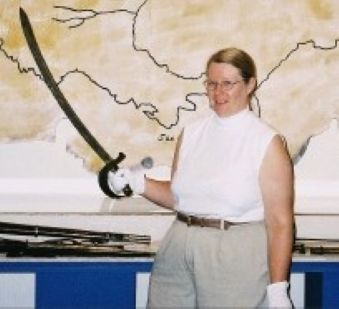  Cutlass,
flintlock, and axe
Cutlass,
flintlock, and axe
(Source: Author)
Blackbeard’s last stand against the Royal Navy was
equally brutal. “Black-beard and the
Lieutenant fired the first Shots at each other, by
which the Pyrate received a Wound, and then engaged
with Swords, till the Lieutenant’s unluckily broke,
and [Maynard] stepping back to cock a Pistol, Black-beard,
with his Cutlash, was striking at that Instant, that
one of Maynard’s Men gave him a terrible Wound in
the Neck and Throat, by which the Lieutenant came
off with only a small Cut over his Fingers. They
were now closely and warmly engaged, the Lieutenant
and twelve Men against Black-beard and fourteen,
till the Sea was tinctur’d with Blood round the
Vessel; Black-beard received a Shot into his
Body from the Pistol that Lieutenant Maynard discharg’d,
yet he stood his Ground, and fought with great Fury,
till he received five and twenty Wounds, and five of
them by Shot. At length, as he was cocking another
Pistol, having fired several before, he fell down
dead; by which Time eight more out of the fourteen
dropp’d, and all the rest, much wounded, jumped
over-board, and call’d out for Quarters, which was
granted, tho’ it was only prolonging their Lives a
few days.” (Defoe, 81-82)
Capture
of the Pirate, Blackbeard, 1718 by Jean Leon
Gerome Ferris (1920)
(Source: Wikimedia
Commons)
These tactics weren’t used only in Caribbean waters.
The Barbary corsairs employed them in the
Mediterranean. They “would fly a foreign flag in
order to ‘lure the unsuspecting victim within
striking distance.’ Then gunners perched on the
rigging would 'ply the shot with unabated rapidity,’
raking the victim’s deck. Meanwhile ‘the fighting
men stand ready, their arms bared, muskets primed,
and scimitars flashing, waiting for the order to
board.’” On the reis’s (captain’s) cue, the corsairs
swarmed the prize. “‘[T]heir war-cry was appalling;
and the fury of the onslaught was such as to strike
panic into the stoutest heart.’ After overcoming the
crew, the pirates chained survivors, who would
become hostages for ransom or slaves for sale,
manned the captured ship, and proceeded to their
home port.” (Lambert, 39)
Planning, intelligence gathering, daring,
quick-thinking, speed, mobility, and the ability to
adapt played roles in whether an endeavor succeeded
or failed. Perhaps this was why Bartholomew
Roberts became one of the most successful
pirates to sail the seas. Once, he and his men
stumbled upon a fleet of forty-two Portuguese ships,
bound for Lisbon, off the Bay of los todos
Santos. Although outnumbered and outmanned,
Roberts sailed Rover into the Portuguese
convoy and “. . . mix’d with the Fleet, and kept his
Men hid till proper Resolutions could be form’d,
that done, they came close up to one of the deepest,
and order’d her to send the Master on board quietly,
threat’ning to give them no Quarters, if any
Resistance, or Signal of Distress was made. The Portuguese
being surprised at these Threats, and the sudden
Flourish of Cutlashes from the Pyrates, submitted
without a Word, and the Captain came on board; Roberts
saluted him after a friendly Manner, telling him
. . . that their Business with him, was only to be
informed which was the richest Ship in that Fleet;
and if he directed them right, he should be restored
to his Ship without Molestation, otherwise, he must
expect immediate Death. Whereupon this Portuguese
Master pointed to one of 40 Guns, and 150 Men, a
Ship of greater Force than the Rover, but
this no Ways dismayed them . . . so immediately
steered away for him. When they came within Hail,
the Master whom they had Prisoner, was ordered to
ask, how Seignior Captain did? and to invite him on
board . . . But by the Bustle that immediately
followed, the Pyrates perceived they were discovered
. . . so without further Delay, they poured in a
Broadside, boarded and grappled her; the Dispute was
short and warm, wherein many of the Portuguese fell,
and two only of the Pyrates.” (Defoe, 204-205)
Within the hold and cabins of the vessel, Roberts
and his men discovered sugar, skins, tobacco, 90,000
gold Moidores, and jewelry, including “a Cross set
with Diamonds, designed for the King of Portugal.”
(Defoe, 205)
For more information, I recommend these books:
Coote,
Stephen. Drake: The Life and Legend of an
Elizabethan Hero. Thomas Dunne Books, 2003.
Cordingly, David. Under
the Black Flag: The Romance and the Reality of
Life Among the Pirates. Random House, 1995.
Defoe, Daniel. A
General History of the Pyrates edited by
Manuel Schonhorn. Dover Publications, 1999. (other
editions of this title list the author as Captain
Charles Johnson)
Esquemeling, John.
[Alexandre Exquemelin] The Buccaneers of
America. The Rio Grande Press, 1992.
Konstam, Angus. Buccaneers
1620-1700. Osprey, 2000.
Konstam, Angus. Elizabethan
Sea Dogs. Osprey, 2000.
Konstam, Angus. Pirates
1660-1730. Osprey, 1998.
Lambert, Frank. The
Barbary Wars: American Independence in the
Atlantic World. Hill and Wang, 2005.
Little, Benerson. The
Sea Rover’s Practice: Pirate Tactics and
Techniques, 1630-1730. Potomac Books, 2005.
Pirates: Terror on
the High Seas -- From the Caribbean to the South
China Sea. Turner Publishing, 1996.
Review
Copyright ©2006 Cindy Vallar
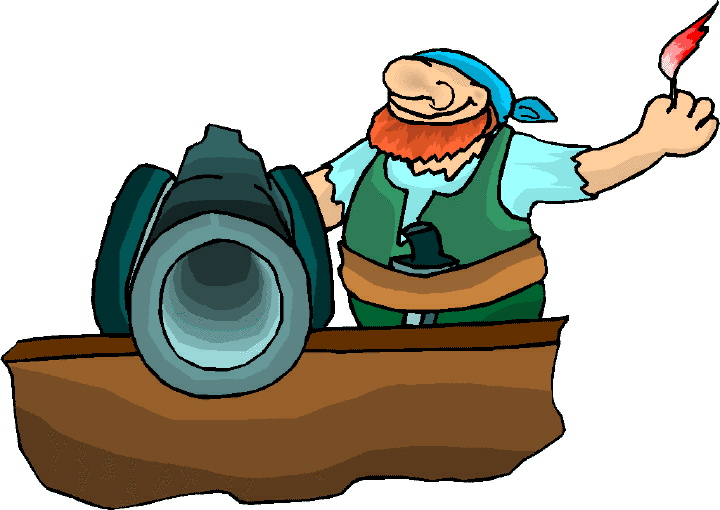
Click to contact me
Background image compliments
of Anke's Graphics |

 Pirates
always interrogated sailors and passengers on seized
vessels. The threat of torture was often enough to
make them talk, but when necessary, pirates tortured
their prisoners. This information needed to be
confirmed whenever possible, for victims would lie
in hopes of saving their lives. Torture also
revealed hidden booty aboard the prize. On 14
September 1723, Princess had almost reached
Barbados when
Pirates
always interrogated sailors and passengers on seized
vessels. The threat of torture was often enough to
make them talk, but when necessary, pirates tortured
their prisoners. This information needed to be
confirmed whenever possible, for victims would lie
in hopes of saving their lives. Torture also
revealed hidden booty aboard the prize. On 14
September 1723, Princess had almost reached
Barbados when 
 In
1579,
In
1579,  Pirates
didn’t always attack ships, especially the
Pirates
didn’t always attack ships, especially the  Once the lookout
sighted a potential target, the pirates did not
immediately attack. They stalked the prey to
identify the type of ship, whether she rode low or
high in the water (full cargo vs. empty hold), and
to determine the prey’s possible firepower. This
intelligence gathering took several hours to several
days. “To discern the details of armament and crew
of an unknown vessel by naked sight alone – whether,
for example, the crew were many or few, and how many
ports or cannon the vessel might have – it had to be
no more than a few hundred yards away, and even then
many details were obscure. And because most
nations had other nations’ vessels in their naval
and merchant fleets . . . it was not possible to
determine nationality solely from design or general
characteristics.” (Little, 109)
Once the lookout
sighted a potential target, the pirates did not
immediately attack. They stalked the prey to
identify the type of ship, whether she rode low or
high in the water (full cargo vs. empty hold), and
to determine the prey’s possible firepower. This
intelligence gathering took several hours to several
days. “To discern the details of armament and crew
of an unknown vessel by naked sight alone – whether,
for example, the crew were many or few, and how many
ports or cannon the vessel might have – it had to be
no more than a few hundred yards away, and even then
many details were obscure. And because most
nations had other nations’ vessels in their naval
and merchant fleets . . . it was not possible to
determine nationality solely from design or general
characteristics.” (Little, 109)

